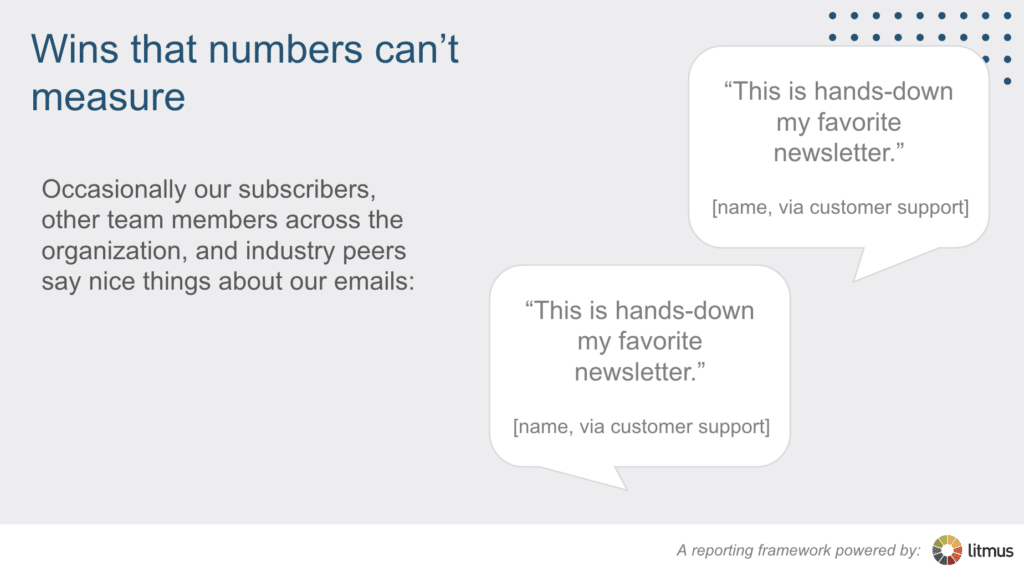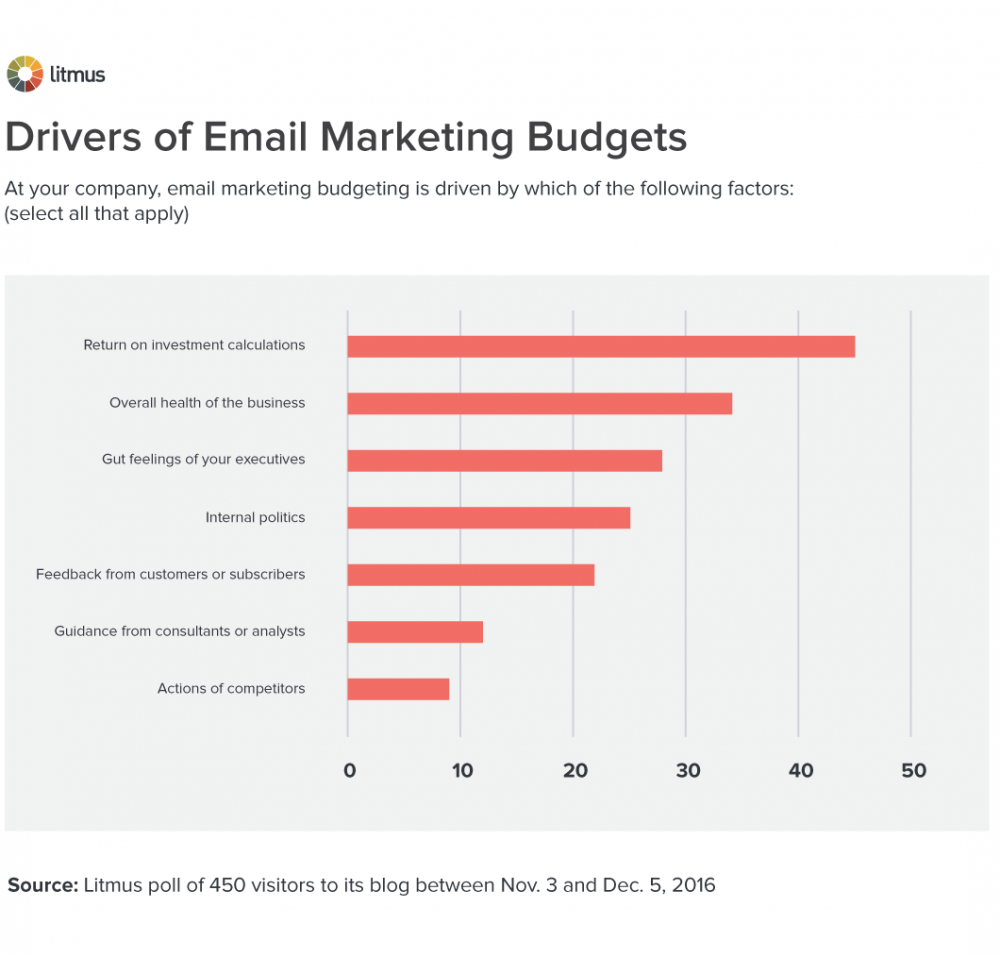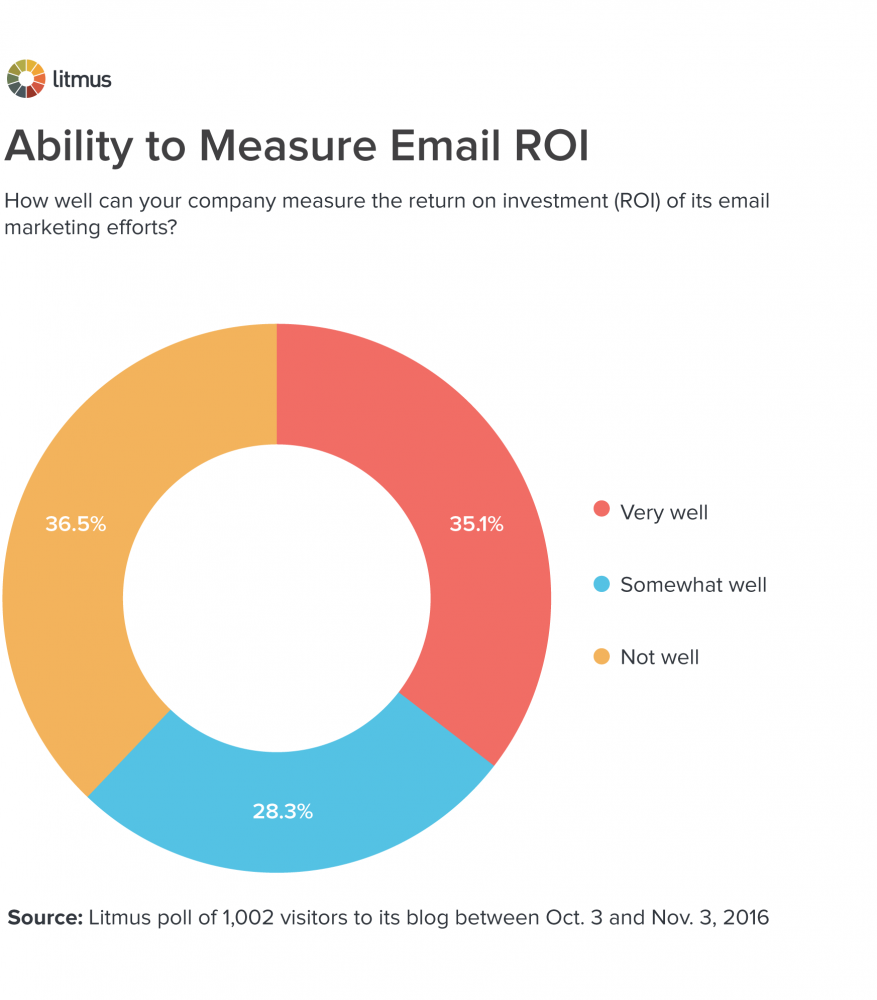8 Ways to Get Executive Buy-In for Larger Email Marketing Budgets, Besides ROI
We’d all like to say our team’s decision-making is perfectly rational and organized…but it isn’t. Or at least not all the time. As much as companies aspire to be data-driven in their budgeting decisions, the reality is that most businesses just aren’t there yet. In theory, using single metrics like ROI to determine marketing budgets is useful—but rarely used.
So, how can you get buy-in for your team’s needs without leaning on the powerful (but elusive) email ROI? Let’s explore.
What is executive ‘buy-in’?
Executive buy-in is a term for having support from your executive team or leadership for a decision. Getting executive buy-in for something like your marketing budget means you convince your manager or executives that your team, department, or tool stack is worth the investment.
Why is executive ‘buy-in’ important for email marketing?
You need (and want) leaders to be on board with your email marketing investment. Apart from the fact that work is much more pleasant when everyone is on the same page, leaders tend to control the company’s purse strings. 💰
You need executive buy-in for your email marketing to pay for raises for your team, buy new tools, continue investing in strategies, or add new team members. Leaders can also offer mentorship and support within your team, plus advocacy with their fellow leaders, so it’s good to have them on your side.
What influences email marketing budgets?
According to a Litmus poll, over one-third of marketers say that two or more factors drive their companies’ email marketing budgets, which makes sense considering businesses involve multiple factors (and humans).
Still, that leaves more than 65% of teams who use a single factor to decide the fate of their marketing budgets. What details can carry that kind of weight? Here are the top drivers of email marketing budgets.
1. Return on investment (ROI) calculations
The most common driver of email marketing budget decisions is the return on investment (ROI). Just over 40% of organizations consider the financial impact of email before deciding on budgets. These numbers are reached by calculations based on the data available—unfortunately, sometimes that data is hard to come by. In situations where the data can’t be found or is limited, other solutions arise.
2. The overall health of the business
The second most frequently used determining factor of email budget is the business’s overall health, with a little more than a third of the votes. For example, companies might experiment with new campaigns when cash flow is comfortable and narrow their focus when the bottom line is shaky. When you can’t measure ROI, leaders are likely to hedge their bets and only run experiments when it’s safe to do so.
3. Gut feelings of your executives
Nearly 30% of teams indicated that their executives’ gut feeling impacts their budget. If you’re in that camp, it’s a good idea to start sharing your wins with leaders early and often before budget-setting time.

Showcase technical and emotional wins to get support from executives.
4. Internal politics
Executives aren’t the only people with the power to make or break marketing budgets—internal politics is the fourth most common reason behind email marketing investment decisions. Breaking out of your silo and prioritizing cross-team collaboration could help when it’s time to advocate for your team.
5. Feedback from customers or subscribers
Just over 20% of companies consider feedback from subscribers when deciding how much to dedicate to email marketing. Maybe now is a good time to test out a feedback poll in your email to learn what they’re loving.
Get inspired with feedback poll example emails
6. Guidance from consultants or analysis
Getting a new perspective can be helpful, which is why around 11% of organizations consider guidance from a consultant when setting their email marketing budget.
7. Actions of competitors
It’s always best to focus on your customers and email marketing program, but some companies can’t help but keep an eye on the competition. (It’s for research purposes, we swear. 😭) While less than 10% of companies factor in competitor actions during budgeting, you can save competitor emails to share during budget pitches.
How well can your company measure email ROI?
While ROI is a common deciding factor in investment decisions, most teams aren’t overly confident in their calculations—only 35% of teams said they can measure email ROI very well. Another 36% say they can measure ROI somewhat well, and 28% aren’t confident in their calculations at all.
How to get email budget buy-in if you can’t calculate ROI
ROI is a compelling number when you’re advocating for email marketing budget, especially since the average email ROI is 36:1. Don’t worry if you don’t have those calculations, though—there are other ways to get executive buy-in for more money in your email program. 💡
Here’s how experts at Adobe, Barkley, eMailMonday, Merkle, Oracle, Red Pill Email, RAPP, and Shaw + Scott recommend you argue for more email marketing resources.
1. Promote “sexier” adjacent activities
Email is old enough to face perennial discussions about its demise (see: the Mailchimp and London Design Museum’s tongue-in-cheek exhibit Email is Dead) and that means that there are plenty of shiny new marketing channels to compete against.
But you can also use that to your advantage, says Jordie van Rijn, an independent email and automation consultant at eMailMonday.
“Budget that goes into customer lifecycle marketing, marketing automation, or data science sounds much better and more innovative than email. In practice, those involve a lot of email marketing activities.” — Jordie Van Rijn
Instead of positioning email as an alternative to new marketing ideas, explain how the two actually go hand-in-hand.
2. Position email more broadly
In addition to piggybacking on enthusiasm for new channels and tactics, break email marketing out of its silo and position it as an important contributor to a range of critical functions.
“It’s hard for email to shake that cheap/easy/not sexy rap,” says Melissa Shaw, Co-CEO and Co-Founder, Shaw + Scott.
“Email marketers need to stress the importance of their role in a cohesive customer experience.” —Melissa Shaw of Shaw + Scott [Tweet this →]
“For example, you can emphasize how email is a great test bed for optimizing marketing overall, honing in on effective segmentation strategies, creative treatments, messaging, offers, etc. You can also show how email interplays with other channels.”
Kristin Naragon, Director of Product Marketing at Adobe Campaign, agrees that email needs to de-silo.
“Email marketers need to position their needs in the context of greater company goals and the customer experience,” she says. “A request will seem less tactical to an executive if the email marketer positions it as a way to accelerate larger company goals, rather than email marketing-specific goals.”
3. Leverage transformative initiatives
Big changes within marketing and the broader company are opportunities to reboot email’s position and stature, says Jose Cebrian, Vice President and General Manager of Email and Mobile Messaging at Merkle.
“When speaking about larger companies, the most effective argument I have seen is by couching the larger budget need in terms of a large-scale CRM marketing transformation,” he says.
“Email, a component of the transformation, will drive a material change in how the company understands its customers and can communicate with them to drive a significant financial impact. As with all initiatives of this scale, it is a multi-year vision with alignment from senior executives across several disciplines.”
4. Leverage regulatory and brand compliance requirements
In the absence of a big, internally driven transformation anywhere on the horizon, look for other drivers—particularly ones that are required changes.
“There are four dimensions on which to rate an email project’s merit: regulatory compliance, brand compliance, return, and innovation,” says Cebrian. “The first two, regulatory and brand compliance, are required.”
These are great initiatives to hitch an email marketing project to, says Cebrian.
“Regulatory-related projects are instituted because a law is being or will be broken. Brand compliance projects take place when there is a brand refresh at the company or a program such as automated emails has been running a long time and the content and branding are out of date. These tend not to provide an increase in return unless coupled with another initiative such as making the emails responsive, but for a brand-conscious company they must be completed.”
5. Collect case studies
While email marketing budgets may not be driven by the actions of competitors at many companies, there’s no doubt that case studies are a powerful persuasion tool. We love to use them, too!
“Case studies are one of the best ways to ‘prove’ that a program is worth investing in,” says Jessica Best, Director of Data-Driven Marketing at Barkley.
“When I can tell clients of a similar industry company that tried something new and saw the results, it takes some of the fear of being on the bleeding edge out of the equation.”
6. Establish proof of concept
Want to accomplish a big email marketing project? Your chances of success are substantially higher if you break the project up into several much smaller initiatives because small, near-term wins give you momentum that you can take into the next phase of the project.
“I’ve seen email marketers be the most successful in securing budgets by building confidence with a series of discrete and measurable wins,” says Shaw.
“For example, you may aspire to invest in a multi-wave, cross-channel browse abandon effort. Can you build a business case by fencing off a couple of messages to a core segment in a single channel and use that to size the opportunity?”
“As an email marketer, you need credible data and a solid test design,” she adds. “Include a hold-out group if you want to be taken seriously by executives.
7. Celebrate your successes
Don’t be quiet about your successes, and don’t hesitate to roll up a series of small successes to make a bigger statement.
“Showcase your wins and publicize them internally,” says Bradford Johnson, Senior Director, Strategic and Analytic Services at Oracle.
“Email often has to do its own PR, so curate extremely brief spotlights of your ongoing wins and distribute these broadly.”
While this can seem like a distraction from your next email marketing task, try to view it as a core part of your job.
“It’s important to follow up once the funding is received to show actual results,” says Jeanne Jennings, VP of Client Strategy and Creative Services at Red Pill Email.
“Often, email marketers think they are too busy to go back and show the results of their efforts and the company’s investment. But doing this on a consistent basis makes getting a larger budget at the beginning of the new year a lot easier.”
Determine the best way within your company to regularly publicize your success, whether that’s via a monthly or quarterly email to stakeholders, a slide deck or Basecamp post that summarizes key results of your initiatives, or an in-person meeting where you can share results and learnings.
In addition to those, Cinnamon Brunmier-Keller, VP of Technology Services at RAPP, recommends video.
“We’ve found that video case studies work better than slide decks to create excitement and inspiration,” she says. “You can also say more in a 3- to 5-minute video—thanks to text animation, imagery, and voiceover—than you can in a 20-page slide presentation.”
8. Find leadership champions
As you celebrate your successes, use those occasions and others to cultivate champions for your future efforts.
“Email marketers need to build alliances within their organizations—with IT, finance, other marketing teams, etc.” —Kristin Naragon of Adobe [Tweet this →]
“Budget requests for solutions that solve multiple teams’ problems are more likely to be better received by an executive, especially when presented with a unified front.”
While cross-functional advocates are great and necessary, you also need to find champions within leadership.
“Email marketers have to successfully ‘manage up’ to executives with excellent analytical skills and storytelling skills,” says Shaw. “It’s an absolute imperative to be networking and building connections within your organization and not operating as a silo.”
Part of cultivating great executive champions is ensuring that they understand all the critical aspects of email marketing.
Use Litmus’ 1-Page Executive Briefs to Gain Buy-In
Company leadership doesn’t always fully understand the value of email marketing, and that creates unnecessary tension and underperformance. Litmus has identified a number of key email marketing topics and assembled 1-page executive briefs that marketers can share with management, including one on Why Companies Are Investing More in Email Marketing.
Download that and other 1-page briefs from our Email Marketing Leadership series for free.

Steph Knapp
Steph Knapp is a Freelance Content Writer for SaaS and B2B companies



